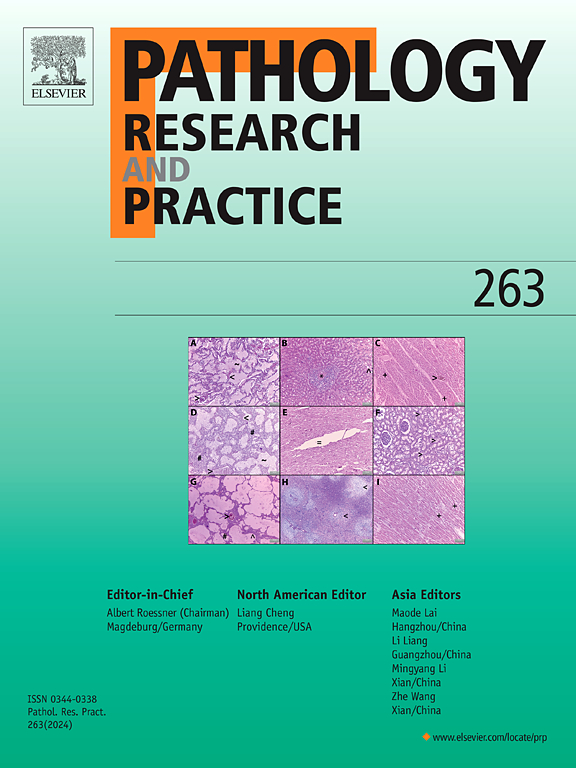TREM-1 as a potential biomarker for malignant transformation risk in oral leukoplakia: Insights from bioinformatics and dual immunofluorescence analysis
IF 2.9
4区 医学
Q2 PATHOLOGY
引用次数: 0
Abstract
Background
Oral leukoplakia (OLK) is a precancerous lesion of oral squamous cell carcinoma (OSCC), but its malignant transformation mechanisms remain unclear. This study investigates TREM-1’s role in OLK progression through bioinformatics and pathological validation, highlighting its potential as a prognostic biomarker for malignant transformation
Methods
TREM-1 expression in OLK was analyzed using Kaplan–Meier and Cox regression based on public datasets identified it as an independent risk factor Cox regression based on GEO clinical data. Single-cell RNA sequencing identified macrophages as the primary TREM-1-expressing cells. Dual-label immunofluorescence was performed on 69 OLK and 63 control tissues to validate TREM-1 expression and its co-localization with CD68. Statistical analysis included non-parametric tests, chi-square tests, and multivariate Cox regression to assess associations with malignant transformation. Significance was defined as p < 0.05.
Results
Kaplan–Meier analysis showed that high TREM-1 expression was significantly associated with OLK malignant transformation (p = 0.007), and Cox regression based on public datasets identified it as an independent risk factor (HR = 2.702, p = 0.032). Single-cell RNA sequencing revealed macrophages as the main TREM-1-expressing cells. Immunofluorescence confirmed elevated TREM-1 expression in OLK macrophages compared to controls. In 69 clinical samples, chi-square analysis supported a significant association with malignant transformation, though this was not confirmed by Cox regression.
Conclusions
This study suggests that TREM-1 may be involved in OLK malignant transformation through macrophages. Although its expression is not related to dysplasia severity, it could serve as a biomarker for assessing the cancerous transformation
TREM-1作为口腔白斑恶性转化风险的潜在生物标志物:来自生物信息学和双免疫荧光分析的见解
背景:口腔白斑是口腔鳞状细胞癌(OSCC)的癌前病变,但其恶性转化机制尚不清楚。本研究通过生物信息学和病理验证来研究TREM-1在OLK进展中的作用,强调其作为恶性转化的预后生物标志物的潜力。方法基于公共数据集,使用Kaplan-Meier和Cox回归分析strem -1在OLK中的表达,并根据GEO临床数据确定其为独立危险因素Cox回归。单细胞RNA测序鉴定巨噬细胞为主要表达trem -1的细胞。对69个OLK组织和63个对照组织进行双标记免疫荧光检测,验证TREM-1的表达及其与CD68的共定位。统计分析包括非参数检验、卡方检验和多变量Cox回归来评估与恶性转化的关系。显著性定义为p <; 0.05。结果kaplan - meier分析显示TREM-1高表达与OLK恶性转化有显著相关性(p = 0.007),基于公开数据集的Cox回归分析认为TREM-1高表达是OLK恶性转化的独立危险因素(HR = 2.702, p = 0.032)。单细胞RNA测序显示巨噬细胞是主要表达trem -1的细胞。免疫荧光证实,与对照组相比,OLK巨噬细胞中TREM-1表达升高。在69个临床样本中,卡方分析支持与恶性转化的显著关联,尽管这未被Cox回归证实。结论TREM-1可能通过巨噬细胞参与OLK的恶性转化。虽然它的表达与发育不良的严重程度无关,但它可以作为评估癌变的生物标志物
本文章由计算机程序翻译,如有差异,请以英文原文为准。
求助全文
约1分钟内获得全文
求助全文
来源期刊
CiteScore
5.00
自引率
3.60%
发文量
405
审稿时长
24 days
期刊介绍:
Pathology, Research and Practice provides accessible coverage of the most recent developments across the entire field of pathology: Reviews focus on recent progress in pathology, while Comments look at interesting current problems and at hypotheses for future developments in pathology. Original Papers present novel findings on all aspects of general, anatomic and molecular pathology. Rapid Communications inform readers on preliminary findings that may be relevant for further studies and need to be communicated quickly. Teaching Cases look at new aspects or special diagnostic problems of diseases and at case reports relevant for the pathologist''s practice.

 求助内容:
求助内容: 应助结果提醒方式:
应助结果提醒方式:


